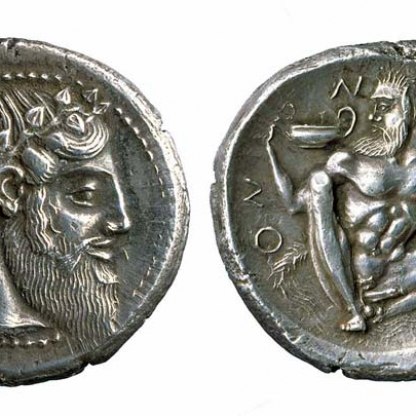Wine Cup

This naked youth, crowned with a laurel wreath, is to be seen in the interior of an ancient Athenian wine cup. It would only become visible to the user as the cup was drained. The boy bends down inside a giant krater, a vessel in which strong Greek wine was diluted with water. In fact there is more than liquid being mixed here. With its themes of male beauty, athletic prowess and wine drinking, the cup neatly encapsulates several of the aristocratic ideals of late sixth-century Athens.
The English word gymnasium derives from the Greek word gumnos, meaning naked, for in ancient Athens athletics were conducted in the nude. On one side of the exterior of the cup, three young men are shown exercising. One strips off his cloak, another, already naked, holds a large round object, probably meant to be a discus, while a third runs before him. These are ephebes – young, well-born Athenian men. The security of Athens rested on her army, and physical prowess in male youth was seen as a sign of moral and civic virtue.
Lest anyone failed to appreciate their broad shoulders and long, well-proportioned limbs, an inscription running around the outside of the cup and concluding in its interior, advertises the excellence of these youths: 'The boy is beautiful. The boy is beautiful. Yes, the boy.' The Greek word used is kalos – an adjective that suggests inner nobility as much as surface beauty.
Nudity, which revealed a man’s physique, was a heroic, even god-like trait. On another, slightly later red-figure vase in the Fitzwilliam, below GR.13.1917, the archetypal Athenian hero Theseus fights a brigand called Sinis. Although a cloak is draped over his arm, his muscular, naked body is revealed as he prepares to thrust his sword home. He is very much the same physical type as the boys on the cup – an ideal ephebe, a heroic image to aspire to and emulate.

Images of heroes like Theseus were often found in gymnasia. But so too were images of Eros, the boyish god of love. Another cup in the Fitzwilliam, left and right [GR.13.1955], shows an athlete next to a finishing post approached by this winged deity, almost his mirror image.
Athletic victory and nudity could provoke an erotic response in the spectator, and gymnasia were places where homosexual relationships were initiated and fostered. Nineteenth-century scholars tended to ignore ‘the unspeakable vice of the Greeks', but it is acknowledged today that pederasty – love between an erastes, an older man, and an eromenos, a youth – played an important educational role in Athenian life. The promising young ephebe would reap the benefits of the older man’s experience and wisdom. Sexual intercourse might take place, but it was not necessarily the primary objective.
Another Greek institution in which pederasty flourished was the symposium – the all-male drinking party. On the other side of this cup we again see three young men, possibly the same three from the gymnasium. They are still nude and they wear crowns that they might have won on the athletics field. But now they cavort around a mixing bowl, like that on the interior, perhaps enjoying the reward for a successful day in the field.
As well as being an occasion for drunkenness, love-making and celebration, the symposium could also give rise to cultivated conversation. One of the most famous accounts of such a banquet was written by the great philosopher Plato in c. 384 BCE. In this, the most entertaining of Plato’s dialogues, a group of eminent Athenians gather to toast the success of the playwright Agathon, who has won a dramatic competition. Each man delivers a speech outlining his theory of love. Towards the end, Alcibiades, a notoriously kalos youth of Athens, drunkenly gatecrashes the party and tells of his unsuccessful attempts to seduce the great philosopher Socrates.
'... I suggested we go along to the gymnasium and take some exercise together, thinking that something was bound to happen there. And, would you believe it, we did our exercises together and wrestled with each other time and again, with not a soul in sight, and still I got no further...[it was] as if I were the lover trying to seduce his beloved, instead of the other way around ...'
This wine cup, with its beautiful athletes, mixing wine and sport, would have been an appropriate vessel, one feels, at Plato’s famous party.
Themes and periods
Data from our collections database
Cup, (A) athletes, (B) revellers, youth at krater (I) youth inside a bell-krater
Legal notes
The Ricketts and Shannon Collection. Bequeathed by Charles Shannon, 1937
Acquisition and important dates
- Method of acquisition: Bequeathed
- Dates: 1937
Dating
red-figured
Place(s) associated
- Athens
Materials used in production
Read more about this recordStories, Contexts and Themes
Other highlight objects you might like
Suggested Curating Cambridge products
Sign up to our emails
Be the first to hear about our news, exhibitions, events and more…






